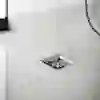Share:
When it comes to the topic of plumbing and drainage systems, a shower trap plays a crucial role in maintaining a well-functioning and hygienic bathroom environment.
Unfortunately, though, the only time many people come across shower traps is when they experience unpleasant odours coming from their own shower drain. Shower drain smells are usually the first sign that a shower trap needs attention.
But what exactly is a shower trap for and why is it so important in this space? Here, The Bathroom Showroom considers the workings of shower traps, highlighting how to deal with such common issues they can pose, and just why this bathroom addition is vital.

The Importance of Shower Traps: What Is a Shower Trap For?
A shower trap is referred to as a waste trap and is also known as a drain trap or P-trap. This is a vital component of your plumbing system. It is typically located beneath the shower drain and is designed to prevent sewer gases from entering your home. The trap works by holding a small amount of water at all times, creating a seal that blocks the passage of odours and gases.
A shower trap, also referred to by some as a shower drain, is a plumbing fixture that is installed beneath the shower floor to prevent debris, hair, soap scum, and other particles from clogging the drainage system. The idea is to trap these particles and allow only water to flow through, ensuring smooth drainage and preventing unpleasant odours escaping through the pipes.
How Does a Shower Trap Work?
When water flows down the shower drain, it enters the shower trap, which is typically a shallow basin with a grated cover. The cover helps to catch larger particles and prevent them from entering the drainage pipes. The water then passes through a series of traps and bends in the pipe, which creates a water seal that blocks foul odours from backing up into the shower.

Why is a Shower Trap Important?
- Preventing Clogs: One of the primary functions of a shower trap is to prevent clogs in the drainage system. By trapping hair, soap residue, and other debris, the shower trap ensures that water can flow freely, reducing the risk of blockages and backups.
- Maintaining Hygiene: A clogged shower drain can lead to stagnant water, mould growth, and foul odours, creating an unsanitary environment in the bathroom. The shower trap helps to maintain hygiene by keeping the drainage system clean and free of blockages.
- Protecting Plumbing: Constantly dealing with clogged drains can put a strain on your plumbing system and lead to costly repairs. By using a shower trap, you can extend the life of your pipes and prevent damage caused by blockages and backups.
- Preventing Odours: Without a shower trap, foul odours from the sewer can back up into your shower, creating an unpleasant and unhygienic environment. The water seal created by the shower trap helps to block these odours and keep your bathroom smelling fresh.
What Are the Different Types of Shower Traps?
The most common types of shower traps are:
- P-trap: Shaped like the letter "P," these are typically used when the waste pipe goes horizontally into the wall.
- S-trap: Shaped like the letter "S," these are used when the waste pipe goes vertically down into the floor.
- Bottle trap: These are more compact and often used in situations where space is limited, like under a shower tray with limited clearance. They have a removable bottom for easier cleaning.
- Gully trap: While not directly under the shower, gully traps are often found outside the house and serve a similar purpose for external drains, preventing smells from entering the system.
- Linear/Wetroom traps: Designed for wetrooms or showers with linear drains, these are often integrated into the floor structure and may feature specialised designs for efficient drainage and maintenance.
Signs of Shower Drain Smells
If you notice foul odours coming from your shower drain, it may be a sign that your shower trap is not functioning correctly. Common causes of shower drain smells include a dry trap, a clog in the trap, or a malfunctioning seal. In addition to unpleasant odours, you may also experience slow drainage or gurgling noises coming from the drain.
Slow drainage: Water pools in the shower tray and takes a long time to drain.
Foul odours: You start to smell unpleasant, sewer-like smells coming from the drain.
Gurgling noises: You might hear gurgling sounds from the drain as water struggles to pass through.
Water backing up: In severe cases, water might back up into the shower tray.
Dealing with Shower Trap Issues
If you suspect that your shower trap is the culprit behind the unpleasant smells in your bathroom, there are a few steps you can take to address the issue.
- Check the Trap: Start by inspecting the trap to see if there are any obvious clogs or blockages.
- Clean the Trap: If the trap is dirty or clogged, you can try cleaning it with a mixture of baking soda and vinegar.
- Maintain the Trap: To prevent future issues, make sure to regularly clean and maintain your shower trap.

How Do I Clean a Shower Trap?
Cleaning a shower trap can vary depending on the type.
- For most traps: You'll often need to unscrew the access plug at the bottom of the trap (if present) or the trap itself. Be prepared for some dirty water! Use a pipe brush, a coat hanger, or even a pair of pliers to remove hair and debris.
- For bottle traps: These are generally easier to clean as the bottom section can be unscrewed for access.
- Chemical drain cleaners: While sometimes effective, use these with caution as they can be harsh on pipes and the environment. Always follow the manufacturer's instructions.
- Plunger: A plunger can sometimes dislodge minor blockages.

How to Maintain Your Shower Trap Long Term
To ensure that your shower trap continues to function effectively, regular maintenance is key. Here are a few tips to keep your shower trap in top condition:
- Clean the Grate: Remove the grate cover periodically and clean out any debris or hair that has accumulated. This will help to prevent clogs and ensure proper water flow.
- Use a Drain Snake and Drain Cleaners: Regularly use drain cleaners or natural solutions such as baking soda and vinegar to prevent build-up in your shower trap.
- Check for Leaks: Inspect your shower trap for any signs of leaks or damage, and repair or replace it if necessary to prevent water damage to your floors and walls.
FAQs About Shower Traps
Are There Different Sizes of Shower Traps?
Yes, shower traps come in various sizes, typically measured by the diameter of the waste pipe (e.g. 40mm or 1.5 inches). It's important to choose a trap that matches the diameter of your shower waste outlet and your existing plumbing.
Can I Install a Shower Trap Myself?
If you have basic DIY plumbing knowledge, it's possible to install a shower trap. However, it's crucial to ensure a watertight seal to prevent leaks. If you're unsure, it's always best to consult a professional plumber.
Why Do I Need a Shower Trap? Can’t I Just Have a Straight Pipe?
You absolutely need a shower trap! Without one, your bathroom would be filled with unpleasant and potentially unhealthy sewer gases (like hydrogen sulfide and methane). These gases can smell terrible and, in high concentrations, can even be dangerous.
What If My Shower Trap Dries Out?
If your shower isn't used for an extended period, the water in the trap can evaporate, breaking the water seal. This will allow sewer gases to enter your bathroom. The solution is simple: just run the shower for a minute or two to refill the trap.
How Often Should I Clean My Shower Trap?
It's a good idea to clean your shower trap every few months, or more frequently if you notice slow drainage or odors. Regular cleaning prevents major blockages.
My Shower Smells Even After Cleaning the Trap. What Else Could It Be?
If the smell persists after cleaning the trap, consider these possibilities:
- Ventilation issues: The plumbing vent stack might be blocked or improperly installed, leading to a siphoning effect that pulls water out of the trap.
- Drainage issues further down: There might be a blockage in the main drain line beyond your shower trap.
- Mould/mildew: Mold or mildew growing in the shower area (grout, sealant) can also produce unpleasant odours.
- Dry floor drain: If you have other floor drains in your bathroom that aren't used often, their traps might be dry.
What’s the Difference Between a Shower Trap and a Floor Drain Trap?
While they both serve to block sewer gases, a shower trap is specifically designed for draining a shower. A floor drain trap is typically found in basements, utility rooms, or public restrooms and handles general floor drainage. The design and size may differ.
Prevent Smelly Shower Drains & Promote A Healthy Environment
Ultimately, a shower trap is a crucial component of your plumbing system that helps maintain hygiene, prevent clogs, protect your plumbing and prevent sewer gases from entering your home.
By understanding what a shower trap is and how to maintain it properly, you can keep your plumbing system running smoothly and odour-free, ensuring a clean and functional shower for years to come.
If you’re looking for further help with choosing the best shower, book an appointment with The Bathroom Showroom. Experts in all things bathrooms, we can help turn your dream bathroom into a reality.
